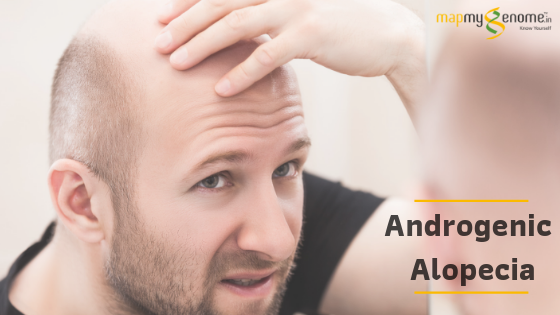
Androgenic alopecia (AGA) is a genetic condition that causes hair loss in men and women. In men, it is called male-pattern baldness or male-pattern hair loss (MPHL). It is also known as hair thinning and starts just above the temple region. Over a period of time, the hair withdraws into ‘M’ shape. Thinning of hair also happens at the upper part of the head (crown), advancing into partial or total baldness. This happens due to hair follicle miniaturization, wherein follicles revert from longer to shorter anagen (the growing phase of a follicle) phases to produce thinner and finer hair. The hair-loss pattern differs between men and women. In women, the thinning occurs across the surface of the head, and the hairline does not retreat. Androgenic alopecia in women leads to hair loss.
Androgenic alopecia in men is linked to various medical conditions like coronary heart disease and expansion of prostate gland. Also, cancer of prostate, diabetes, obesity, and hypertension have been associated with androgenic alopecia.
How Common Is It?
Androgenetic alopecia is one of the most frequent causes of baldness/hair loss in both men and women. In the US alone, nearly 50 million men and 30 million women are affected with MPHL. AGA starts in the early teens and the symptoms increase with age. Nearly 50% of all the men have some form of baldness. In women, hair loss usually starts after menopause. It is more in the Caucasian population than in any others. In India, AGA has 58% prevalence in men and 19% in Caucasian women population.
Clinical Features:
- Slow onset of hair thinning on top of the head
- Round bald spots/patches
- Total-body hair loss
- Change in the inner areas from thick to thin and short hair
- Patches spanning the entire scalp
Risk factors:
- Age — AGA’s severity increases with age, especially after 40 years.
- Excess levels of circulating androgens such as testosterone and dihydrotestosterone (DHT)
- Family history in maternal relatives
Complications:
- Obesity, metabolic syndrome, insulin resistance (due to hormonal imbalances)
- Anxiety and depression
Preventive measures:
- Avoid harsh techniques (e.g., chemical dyes, blow drying) to protect hair follicles and minimize risk for hair fall.
- Visit a trichologist if you notice symptoms or wish to adopt a preventive hair care regime. In some cases, a hair supplement may be required.
- Ensure adequate dietary intake of proteins, omega 3-, zinc-, biotin-, vitamin A-, C-, D- and E- -rich foods. Deficiency of these nutrients can significantly affect hair health.
- Since AGA has a very strong genetic component (up to 80% heritable), consult a genetic counsellor if there is family history, for overall risk assessment.
Managing Androgenic Alopecia: Risk- Diet and Lifestyle:
Treatment:
Treatment to baldness is hardly relevant if one is comfortable with the appearance. Weaving of hair, hairpieces, and a change in the hairstyle are some of the cheapest and safest methods to combat male-pattern baldness. Medicines like minoxidil, finasteride, and dutasteride are generally used to treat androgenic alopecia. Hair transplantation is considered another approach towards treating baldness. It involves taking small plugs of hair from areas where the hair is growing and putting them in the areas of baldness. Initially, there are chances of causing scars, infections, and scalp abscess. Hair-transplantation is expensive and banned by the FDA due to increased infection rate.
When to Contact a Medical Professional:
It is advisable to consult a health care provider/physician when
- Loss of hair happens atypically at a rapid rate
- Loss of hair occurs in patches with extensive spreading
- Loss of hair leads to itching, irritation on the skin, pain, etc.
- Loss of hair starts after taking medicine
(Source: https://visual.ly/community/infographic/health/different-types-hair-loss)
Do Genes Have Anything To Do With It?
The primary pathways involved in AGA development are regulated by genes that code for Androgen Receptor (AR). The FOXA2 (forkhead box A2) gene (expressed in prostate tissue) produces a transcription factor that interacts with androgen receptor (AR) and regulates gene expression. Histone deacetylase-9 and – 4 (HDAC 9, HDAC 4) are well expressed in hair follicles and inhibit androgen transactivation, thereby causing loss of androgen sensitivity. Other genes that have been found relevant to AGA are IMP5 (intramembrane protease 5), AUTS2 (autism susceptibility candidate 2), TARDBP (TAR DNA Binding Protein) and SETBP1 (SET Binding Protein 1). AUTS2 and SETBP1 are abundantly expressed in hair, skin, and scalp.
How Can Mapmygenome Help You:
At Mapmygenome, our focus is mainly on predictive risk assessment, maintaining a proper diet, and adopting a healthier lifestyle. A comprehensive wellness assessment like Genomepatri will give an insight into the weaknesses of your immunity, genetic predisposition to specific health conditions, drug efficiency and helps in pre-empting most of these risks. Genetic counselling is recommended to obtain authenticated reviewing and testing/screening options, diet/lifestyle interventions, and educational and emotional support.
Tapping into your genes will assist you to know the real ‘YOU’. Genomepatri helps you find the best-suited route for yourself and reiterates the importance of not following the crowd but forging a unique way of leading quality life. It is personalized, predictive, participatory, preventive, and POWERFUL!!!
References:
- Reference, G. (2019). Androgenetic alopecia. [online] Genetics Home Reference. Available at: https://ghr.nlm.nih.gov/condition/androgenetic-alopecia [Accessed 4 Sep. 2019].
- Kaliyadan, Feroze, Ajit Nambiar, and Sundeep Vijayaraghavan. “Androgenetic alopecia: an update.” Indian Journal of Dermatology, Venereology, and Leprology 79.5 (2013): 613.





